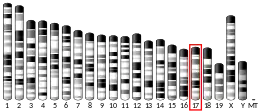Mitochondrial uncoupling protein 4
Mitochondrial uncoupling protein 4 is a protein that in humans is encoded by the SLC25A27 gene.[5][6][7]
Mitochondrial uncoupling proteins (UCP) are members of the larger family of mitochondrial anion carrier proteins (MACP). UCPs separate oxidative phosphorylation from ATP synthesis with energy dissipated as heat, also referred to as the mitochondrial proton leak. UCPs facilitate the transfer of anions from the inner to the outer mitochondrial membrane and the return transfer of protons from the outer to the inner mitochondrial membrane. They also reduce the mitochondrial membrane potential in mammalian cells. Tissue specificity occurs for the different UCPs and the exact methods of how UCPs transfer H+/OH- are not known. UCPs contain the three homologous protein domains of MACPs. Transcripts of this gene are detected only in brain tissue and are specifically modulated by various environmental conditions.[7] Recently, the proton transport activity of UCP4 has also been shown to be activated by fatty acids and inhibited by purine nucleotides.[8] In addition, reconstituted UCP4 exhibited a distinct conformation, compared to other UCPs in the family.[9]
See also
References
- GRCh38: Ensembl release 89: ENSG00000153291 - Ensembl, May 2017
- GRCm38: Ensembl release 89: ENSMUSG00000023912 - Ensembl, May 2017
- "Human PubMed Reference:". National Center for Biotechnology Information, U.S. National Library of Medicine.
- "Mouse PubMed Reference:". National Center for Biotechnology Information, U.S. National Library of Medicine.
- Mao W, Yu XX, Zhong A, Li W, Brush J, Sherwood SW, Adams SH, Pan G (Mar 1999). "UCP4, a novel brain-specific mitochondrial protein that reduces membrane potential in mammalian cells". FEBS Lett. 443 (3): 326–30. doi:10.1016/S0014-5793(98)01713-X. PMID 10025957. S2CID 314036.
- Jezek P, Urbankova E (Jun 2000). "Specific sequence of motifs of mitochondrial uncoupling proteins". IUBMB Life. 49 (1): 63–70. doi:10.1080/713803586. PMID 10772343. S2CID 8541209.
- "Entrez Gene: SLC25A27 solute carrier family 25, member 27".
- Hoang T, Smith MD, Jelokhani-Niaraki M (2012). "Toward Understanding the Mechanism of Ion Transport Activity of Neuronal Uncoupling Proteins UCP2, UCP4, and UCP5". Biochemistry. 51 (19): 4004–14. doi:10.1021/bi3003378. PMID 22524567.
- Ivanova M, Hoang T, McSorly FR, Krnac G, Smith MD, Jelokhani-Niaraki M (2010). "A comparative study on conformation and ligand binding of the neuronal uncoupling proteins". Biochemistry. 49 (3): 512–21. doi:10.1021/bi901742g. PMID 20000716.
Further reading
- Ricquier D, Bouillaud F (2000). "The uncoupling protein homologues: UCP1, UCP2, UCP3, StUCP and AtUCP". Biochem. J. 345 (2): 161–79. doi:10.1042/0264-6021:3450161. PMC 1220743. PMID 10620491.
- Muzzin P (2002). "The uncoupling proteins". Ann. Endocrinol. 63 (2 Pt 1): 106–10. PMID 11994670.
- Bonaldo MF, Lennon G, Soares MB (1997). "Normalization and subtraction: two approaches to facilitate gene discovery". Genome Res. 6 (9): 791–806. doi:10.1101/gr.6.9.791. PMID 8889548.
- Yu XX, Mao W, Zhong A, et al. (2000). "Characterization of novel UCP5/BMCP1 isoforms and differential regulation of UCP4 and UCP5 expression through dietary or temperature manipulation". FASEB J. 14 (11): 1611–8. doi:10.1096/fj.14.11.1611. PMID 10928996.
- Strausberg RL, Feingold EA, Grouse LH, et al. (2003). "Generation and initial analysis of more than 15,000 full-length human and mouse cDNA sequences". Proc. Natl. Acad. Sci. U.S.A. 99 (26): 16899–903. Bibcode:2002PNAS...9916899M. doi:10.1073/pnas.242603899. PMC 139241. PMID 12477932.
- Clark HF, Gurney AL, Abaya E, et al. (2003). "The secreted protein discovery initiative (SPDI), a large-scale effort to identify novel human secreted and transmembrane proteins: a bioinformatics assessment". Genome Res. 13 (10): 2265–70. doi:10.1101/gr.1293003. PMC 403697. PMID 12975309.
- Ota T, Suzuki Y, Nishikawa T, et al. (2004). "Complete sequencing and characterization of 21,243 full-length human cDNAs". Nat. Genet. 36 (1): 40–5. doi:10.1038/ng1285. PMID 14702039.
- Liu D, Chan SL, de Souza-Pinto NC, et al. (2007). "Mitochondrial UCP4 mediates an adaptive shift in energy metabolism and increases the resistance of neurons to metabolic and oxidative stress". Neuromolecular Med. 8 (3): 389–414. doi:10.1385/NMM:8:3:389. PMID 16775390. S2CID 7377782.
- Chan SL, Liu D, Kyriazis GA, et al. (2007). "Mitochondrial uncoupling protein-4 regulates calcium homeostasis and sensitivity to store depletion-induced apoptosis in neural cells". J. Biol. Chem. 281 (49): 37391–403. doi:10.1074/jbc.M605552200. PMID 17035241.
- Yasuno K, Ando S, Misumi S, et al. (2007). "Synergistic association of mitochondrial uncoupling protein (UCP) genes with schizophrenia". Am. J. Med. Genet. B Neuropsychiatr. Genet. 144 (2): 250–3. doi:10.1002/ajmg.b.30443. PMID 17066476. S2CID 30129988.
- Ho PW, Ho JW, Tse HM, et al. (2012). "Uncoupling protein-4 (UCP4) increases ATP supply by interacting with mitochondrial Complex II in neuroblastoma cells". PLOS ONE. 7 (2): e32810. Bibcode:2012PLoSO...732810H. doi:10.1371/journal.pone.0032810. PMC 3303587. PMID 22427795.
- Ho JW, Ho PW, Liu HF, et al. (2012). "UCP4 is a target effector of the NF-κB c-Rel prosurvival pathway against oxidative stress". Free Radic Biol Med. 53 (2): 383–394. doi:10.1016/j.freeradbiomed.2012.05.002. PMID 22580300.
This article incorporates text from the United States National Library of Medicine, which is in the public domain.



